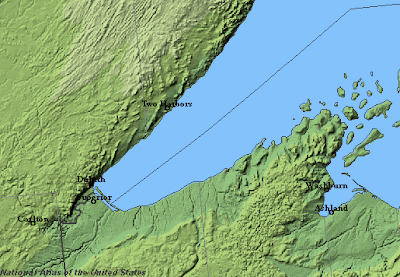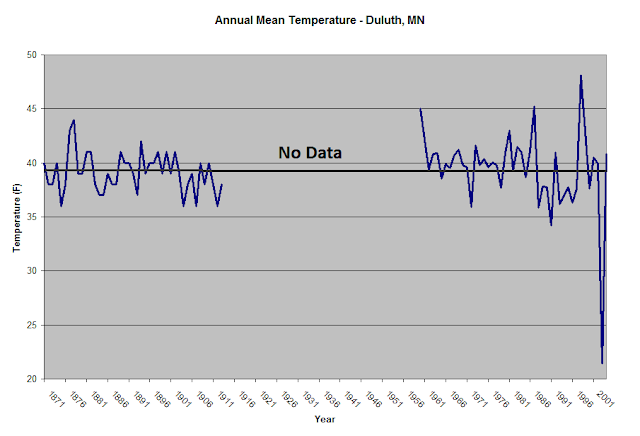The Potential Impacts of Global Climate Change on Duluth, MN
Final Blog
While Duluth's mid-continental location spares he city from areas of potentially significant impacts of climate change such as small islands and coastal regions, Duluth is not immune to climate change. Not surprisingly, global climate change will affect all areas of the planet not matter their proximity to oceans, the equator, or anywhere else. The question is, how much of the looming giant that is global climate change will fall upon Duluth?
- Intergovernmental Panel on Climate Change (IPCC) projections
While the short-sighted might agree that this shift in climate make their lawns greener and nothing more miss the damage that climate change could bring to the Lake Superior region. in addition to the IPCC's predictions, the University of Minnesota SeaGrant Program predicts: dryer summers with a reduction in soil moisture content, warmer nights, increased frequency and intensity of weather events, increased variability of climate with more instances of extremes, a lowered lake level due to increased evaporation, longer growing seasons, and impacts to species in all ecosystems. Needless to say, 'warmer and wetter' is not the whole story.
- Extreme event projections
According to UMN's SeaGrant, consensus among some climatologists indicated that the increase on extreme events in the Lake Superior region will create dramatically different climate than that which exist today. They predict a normal day will feature widely variable high and low temperatures that push into the extremes, and the area will be increasingly plagued by opposing periods of drought and excess precipitation.
- Local impacts of climate change
The most basic impact to consider for Duluth is the effect of increasing temperatures on energy resources. Incresing temperatures would likely affect the use of energy hogs such as air-conditioners. This increased demand is sure to coincide with increased energy demand throughout the world as temperatures rise.
A more direct and major potential consequence is the reduction of water levels in Great Lakes/ Lake Superior, which could seriously harm Duluth and northern Minnesota's economy. Sea-faring vessels come from all over the world to load up on taconite pellets (refined iron ore) mined from Minnesota's Mesabi Iron Range. If these ships cannot reach the port's loading infrastructure the important taconite industry would be instantly crippled. Duluth's economy is also centered upon tourism which is restricted mainly to harbor activities and outdoor activities. A closing of the harbor and/or reduction in wildlife would also hurt the important local service-based economic sector.
Global climate change threatens the environment in a major way besides a potential reduction of the Great Lakes' volume. A rise in surface temperatures on Lake Superior has been observed since 1980, and with the prospect of increase future warming this trend is likely to increase, possibly at a higher rate of change. Over the last three decades, the surface temperature of the lake has increased 2 degrees F ever year, a rate of increase twice that which was recorded on nearby land. This two-pronged effect of decreased water levels and increased surface temperatures could severely disrupt and decrease the rich biodiversity of the area. Because of this, the non-humans of the Duluth area are the most likely to take the brunt of potentially anthropogenic climate change. Interstingly, for reasons attributed to global climate change, many birds appear to have extended their northern migration into Duluth, reaching a record of 74 birds species present during a 2000 count. This largely anecdotal evidence serves to illustrate how the many varied inputs of climate change can create many different outcomes. It also conveys the way which global ecosystem stresses will cause many various patterns of migration, shrinking and expansion of habitats, as well as increased isolation of species.
- Duluth's climate change mitigation measures
In response to emerging research regarding the reality of global climate change, Duluth became a part of of the "Cities for Climate Protection Campaign" sponsored by the International Council for Local Environmental Issues (ICLEI) in 2001. By passing a resolution to join this project, the city will work towards the goal of a 20% reduction of carbon emissions and other pollutants by 2020. Whether or not the city will attain this goal remains to be seen. Towards this end however, the city completes greenhouse gas emission assessments to target areas of concern, establishes a structured set of emission reduction targets, and creates a sound strategy to meet these targets. In practice, moves to meet these targets involve many small steps such as a switch to LED streetlights.
Fourth Assessment Report of the Intergovernmental Panel on Climate Change - Sythesis Report- Summary for Policymakers, 2007, http://www.ipcc.ch/pdf/assessmentreport/ar4/syr/ar4_syr_spm.pdf
"Global Warming, What is Duluth Doing About It?", http://www.doitgreen.org/article/gw/duluth.
"Managing the Risks of Extreme Events and Disasters to Advance Climate Change Adaptation - Summary for Policymakers", http://ipcc-wg2.gov/SREX/images/uploads/SREXSPM
brochure_FINAL.pdf
'Minnesota Climate Change Action Plan", http://www.pca.state.mn.us/index.php/component/
option,com_docman/task,doc_view/gid,9237.










